Ying Nie
Leveraging LLMs to Evaluate Usefulness of Document
Jun 11, 2025Abstract:The conventional Cranfield paradigm struggles to effectively capture user satisfaction due to its weak correlation between relevance and satisfaction, alongside the high costs of relevance annotation in building test collections. To tackle these issues, our research explores the potential of leveraging large language models (LLMs) to generate multilevel usefulness labels for evaluation. We introduce a new user-centric evaluation framework that integrates users' search context and behavioral data into LLMs. This framework uses a cascading judgment structure designed for multilevel usefulness assessments, drawing inspiration from ordinal regression techniques. Our study demonstrates that when well-guided with context and behavioral information, LLMs can accurately evaluate usefulness, allowing our approach to surpass third-party labeling methods. Furthermore, we conduct ablation studies to investigate the influence of key components within the framework. We also apply the labels produced by our method to predict user satisfaction, with real-world experiments indicating that these labels substantially improve the performance of satisfaction prediction models.
Circle-RoPE: Cone-like Decoupled Rotary Positional Embedding for Large Vision-Language Models
May 22, 2025Abstract:Rotary Position Embedding (RoPE) is a widely adopted technique for encoding relative positional information in large language models (LLMs). However, when extended to large vision-language models (LVLMs), its variants introduce unintended cross-modal positional biases. Specifically, they enforce relative positional dependencies between text token indices and image tokens, causing spurious alignments. This issue arises because image tokens representing the same content but located at different spatial positions are assigned distinct positional biases, leading to inconsistent cross-modal associations. To address this, we propose Per-Token Distance (PTD) - a simple yet effective metric for quantifying the independence of positional encodings across modalities. Informed by this analysis, we introduce Circle-RoPE, a novel encoding scheme that maps image token indices onto a circular trajectory orthogonal to the linear path of text token indices, forming a cone-like structure. This configuration ensures that each text token maintains an equal distance to all image tokens, reducing artificial cross-modal biases while preserving intra-image spatial information. To further enhance performance, we propose a staggered layer strategy that applies different RoPE variants across layers. This design leverages the complementary strengths of each RoPE variant, thereby enhancing the model's overall performance. Our experimental results demonstrate that our method effectively preserves spatial information from images while reducing relative positional bias, offering a more robust and flexible positional encoding framework for LVLMs. The code is available at [https://github.com/lose4578/CircleRoPE](https://github.com/lose4578/CircleRoPE).
Foundation Models for Geospatial Reasoning: Assessing Capabilities of Large Language Models in Understanding Geometries and Topological Spatial Relations
May 22, 2025Abstract:Applying AI foundation models directly to geospatial datasets remains challenging due to their limited ability to represent and reason with geographical entities, specifically vector-based geometries and natural language descriptions of complex spatial relations. To address these issues, we investigate the extent to which a well-known-text (WKT) representation of geometries and their spatial relations (e.g., topological predicates) are preserved during spatial reasoning when the geospatial vector data are passed to large language models (LLMs) including GPT-3.5-turbo, GPT-4, and DeepSeek-R1-14B. Our workflow employs three distinct approaches to complete the spatial reasoning tasks for comparison, i.e., geometry embedding-based, prompt engineering-based, and everyday language-based evaluation. Our experiment results demonstrate that both the embedding-based and prompt engineering-based approaches to geospatial question-answering tasks with GPT models can achieve an accuracy of over 0.6 on average for the identification of topological spatial relations between two geometries. Among the evaluated models, GPT-4 with few-shot prompting achieved the highest performance with over 0.66 accuracy on topological spatial relation inference. Additionally, GPT-based reasoner is capable of properly comprehending inverse topological spatial relations and including an LLM-generated geometry can enhance the effectiveness for geographic entity retrieval. GPT-4 also exhibits the ability to translate certain vernacular descriptions about places into formal topological relations, and adding the geometry-type or place-type context in prompts may improve inference accuracy, but it varies by instance. The performance of these spatial reasoning tasks offers valuable insights for the refinement of LLMs with geographical knowledge towards the development of geo-foundation models capable of geospatial reasoning.
* 33 pages, 13 figures, IJGIS GeoFM Special Issue
FltLM: An Intergrated Long-Context Large Language Model for Effective Context Filtering and Understanding
Oct 09, 2024
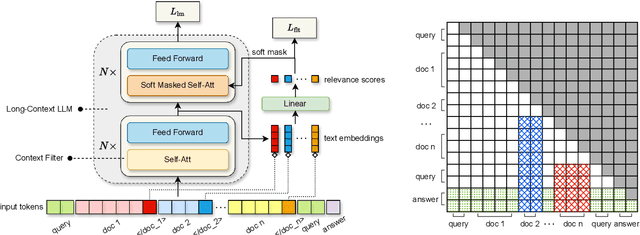


Abstract:The development of Long-Context Large Language Models (LLMs) has markedly advanced natural language processing by facilitating the process of textual data across long documents and multiple corpora. However, Long-Context LLMs still face two critical challenges: The lost in the middle phenomenon, where crucial middle-context information is likely to be missed, and the distraction issue that the models lose focus due to overly extended contexts. To address these challenges, we propose the Context Filtering Language Model (FltLM), a novel integrated Long-Context LLM which enhances the ability of the model on multi-document question-answering (QA) tasks. Specifically, FltLM innovatively incorporates a context filter with a soft mask mechanism, identifying and dynamically excluding irrelevant content to concentrate on pertinent information for better comprehension and reasoning. Our approach not only mitigates these two challenges, but also enables the model to operate conveniently in a single forward pass. Experimental results demonstrate that FltLM significantly outperforms supervised fine-tuning and retrieval-based methods in complex QA scenarios, suggesting a promising solution for more accurate and reliable long-context natural language understanding applications.
Cross-video Identity Correlating for Person Re-identification Pre-training
Sep 27, 2024



Abstract:Recent researches have proven that pre-training on large-scale person images extracted from internet videos is an effective way in learning better representations for person re-identification. However, these researches are mostly confined to pre-training at the instance-level or single-video tracklet-level. They ignore the identity-invariance in images of the same person across different videos, which is a key focus in person re-identification. To address this issue, we propose a Cross-video Identity-cOrrelating pre-traiNing (CION) framework. Defining a noise concept that comprehensively considers both intra-identity consistency and inter-identity discrimination, CION seeks the identity correlation from cross-video images by modeling it as a progressive multi-level denoising problem. Furthermore, an identity-guided self-distillation loss is proposed to implement better large-scale pre-training by mining the identity-invariance within person images. We conduct extensive experiments to verify the superiority of our CION in terms of efficiency and performance. CION achieves significantly leading performance with even fewer training samples. For example, compared with the previous state-of-the-art~\cite{ISR}, CION with the same ResNet50-IBN achieves higher mAP of 93.3\% and 74.3\% on Market1501 and MSMT17, while only utilizing 8\% training samples. Finally, with CION demonstrating superior model-agnostic ability, we contribute a model zoo named ReIDZoo to meet diverse research and application needs in this field. It contains a series of CION pre-trained models with spanning structures and parameters, totaling 32 models with 10 different structures, including GhostNet, ConvNext, RepViT, FastViT and so on. The code and models will be made publicly available at https://github.com/Zplusdragon/CION_ReIDZoo.
CFinBench: A Comprehensive Chinese Financial Benchmark for Large Language Models
Jul 02, 2024



Abstract:Large language models (LLMs) have achieved remarkable performance on various NLP tasks, yet their potential in more challenging and domain-specific task, such as finance, has not been fully explored. In this paper, we present CFinBench: a meticulously crafted, the most comprehensive evaluation benchmark to date, for assessing the financial knowledge of LLMs under Chinese context. In practice, to better align with the career trajectory of Chinese financial practitioners, we build a systematic evaluation from 4 first-level categories: (1) Financial Subject: whether LLMs can memorize the necessary basic knowledge of financial subjects, such as economics, statistics and auditing. (2) Financial Qualification: whether LLMs can obtain the needed financial qualified certifications, such as certified public accountant, securities qualification and banking qualification. (3) Financial Practice: whether LLMs can fulfill the practical financial jobs, such as tax consultant, junior accountant and securities analyst. (4) Financial Law: whether LLMs can meet the requirement of financial laws and regulations, such as tax law, insurance law and economic law. CFinBench comprises 99,100 questions spanning 43 second-level categories with 3 question types: single-choice, multiple-choice and judgment. We conduct extensive experiments of 50 representative LLMs with various model size on CFinBench. The results show that GPT4 and some Chinese-oriented models lead the benchmark, with the highest average accuracy being 60.16%, highlighting the challenge presented by CFinBench. The dataset and evaluation code are available at https://cfinbench.github.io/.
PanGu-$π$: Enhancing Language Model Architectures via Nonlinearity Compensation
Dec 27, 2023



Abstract:The recent trend of large language models (LLMs) is to increase the scale of both model size (\aka the number of parameters) and dataset to achieve better generative ability, which is definitely proved by a lot of work such as the famous GPT and Llama. However, large models often involve massive computational costs, and practical applications cannot afford such high prices. However, the method of constructing a strong model architecture for LLMs is rarely discussed. We first analyze the state-of-the-art language model architectures and observe the feature collapse problem. Based on the theoretical analysis, we propose that the nonlinearity is also very important for language models, which is usually studied in convolutional neural networks for vision tasks. The series informed activation function is then introduced with tiny calculations that can be ignored, and an augmented shortcut is further used to enhance the model nonlinearity. We then demonstrate that the proposed approach is significantly effective for enhancing the model nonlinearity through carefully designed ablations; thus, we present a new efficient model architecture for establishing modern, namely, PanGu-$\pi$. Experiments are then conducted using the same dataset and training strategy to compare PanGu-$\pi$ with state-of-the-art LLMs. The results show that PanGu-$\pi$-7B can achieve a comparable performance to that of benchmarks with about 10\% inference speed-up, and PanGu-$\pi$-1B can achieve state-of-the-art performance in terms of accuracy and efficiency. In addition, we have deployed PanGu-$\pi$-7B in the high-value domains of finance and law, developing an LLM named YunShan for practical application. The results show that YunShan can surpass other models with similar scales on benchmarks.
UFineBench: Towards Text-based Person Retrieval with Ultra-fine Granularity
Dec 11, 2023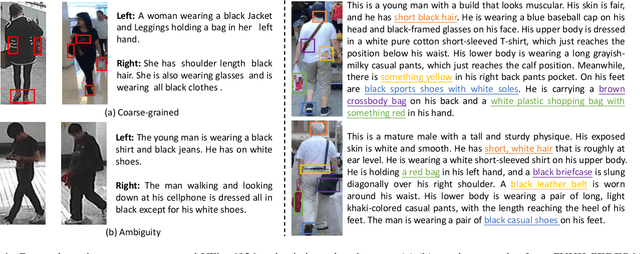

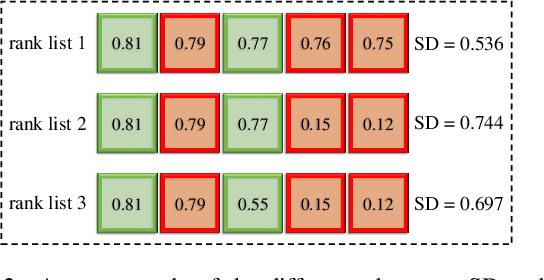

Abstract:Existing text-based person retrieval datasets often have relatively coarse-grained text annotations. This hinders the model to comprehend the fine-grained semantics of query texts in real scenarios. To address this problem, we contribute a new benchmark named \textbf{UFineBench} for text-based person retrieval with ultra-fine granularity. Firstly, we construct a new \textbf{dataset} named UFine6926. We collect a large number of person images and manually annotate each image with two detailed textual descriptions, averaging 80.8 words each. The average word count is three to four times that of the previous datasets. In addition of standard in-domain evaluation, we also propose a special \textbf{evaluation paradigm} more representative of real scenarios. It contains a new evaluation set with cross domains, cross textual granularity and cross textual styles, named UFine3C, and a new evaluation metric for accurately measuring retrieval ability, named mean Similarity Distribution (mSD). Moreover, we propose CFAM, a more efficient \textbf{algorithm} especially designed for text-based person retrieval with ultra fine-grained texts. It achieves fine granularity mining by adopting a shared cross-modal granularity decoder and hard negative match mechanism. With standard in-domain evaluation, CFAM establishes competitive performance across various datasets, especially on our ultra fine-grained UFine6926. Furthermore, by evaluating on UFine3C, we demonstrate that training on our UFine6926 significantly improves generalization to real scenarios compared with other coarse-grained datasets. The dataset and code will be made publicly available at \url{https://github.com/Zplusdragon/UFineBench}.
LightCLIP: Learning Multi-Level Interaction for Lightweight Vision-Language Models
Dec 01, 2023Abstract:Vision-language pre-training like CLIP has shown promising performance on various downstream tasks such as zero-shot image classification and image-text retrieval. Most of the existing CLIP-alike works usually adopt relatively large image encoders like ResNet50 and ViT, while the lightweight counterparts are rarely discussed. In this paper, we propose a multi-level interaction paradigm for training lightweight CLIP models. Firstly, to mitigate the problem that some image-text pairs are not strictly one-to-one correspondence, we improve the conventional global instance-level alignment objective by softening the label of negative samples progressively. Secondly, a relaxed bipartite matching based token-level alignment objective is introduced for finer-grained alignment between image patches and textual words. Moreover, based on the observation that the accuracy of CLIP model does not increase correspondingly as the parameters of text encoder increase, an extra objective of masked language modeling (MLM) is leveraged for maximizing the potential of the shortened text encoder. In practice, an auxiliary fusion module injecting unmasked image embedding into masked text embedding at different network stages is proposed for enhancing the MLM. Extensive experiments show that without introducing additional computational cost during inference, the proposed method achieves a higher performance on multiple downstream tasks.
Species196: A One-Million Semi-supervised Dataset for Fine-grained Species Recognition
Sep 26, 2023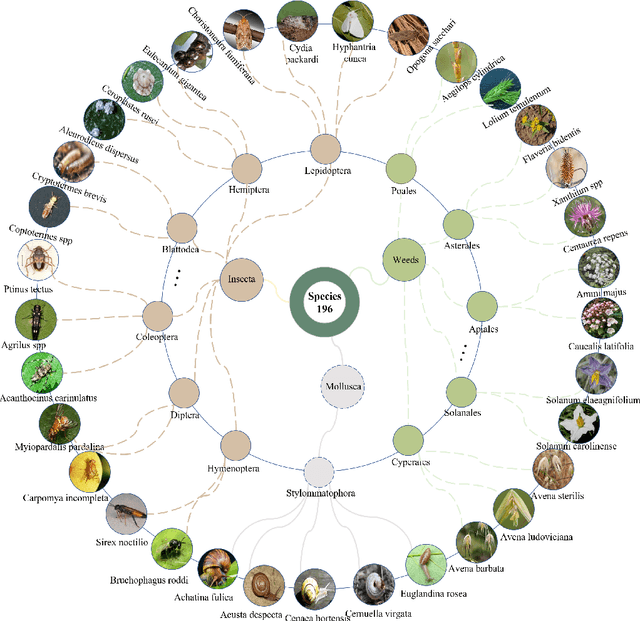
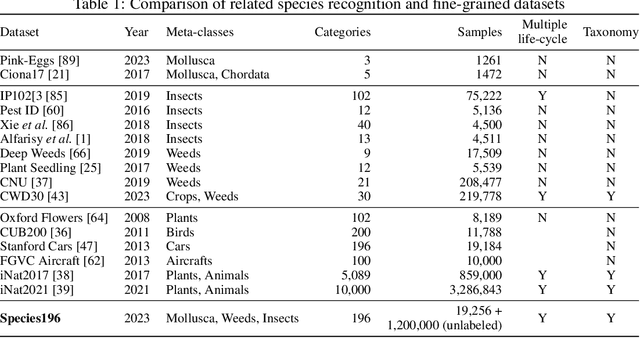
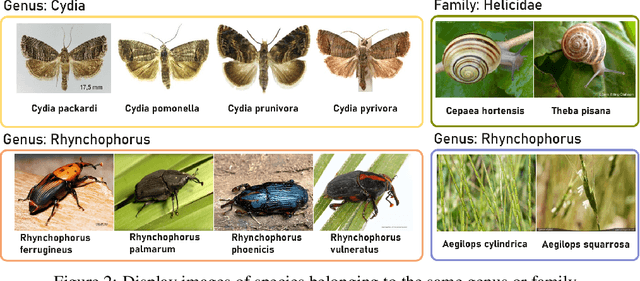

Abstract:The development of foundation vision models has pushed the general visual recognition to a high level, but cannot well address the fine-grained recognition in specialized domain such as invasive species classification. Identifying and managing invasive species has strong social and ecological value. Currently, most invasive species datasets are limited in scale and cover a narrow range of species, which restricts the development of deep-learning based invasion biometrics systems. To fill the gap of this area, we introduced Species196, a large-scale semi-supervised dataset of 196-category invasive species. It collects over 19K images with expert-level accurate annotations Species196-L, and 1.2M unlabeled images of invasive species Species196-U. The dataset provides four experimental settings for benchmarking the existing models and algorithms, namely, supervised learning, semi-supervised learning, self-supervised pretraining and zero-shot inference ability of large multi-modal models. To facilitate future research on these four learning paradigms, we conduct an empirical study of the representative methods on the introduced dataset. The dataset is publicly available at https://species-dataset.github.io/.
 Add to Chrome
Add to Chrome Add to Firefox
Add to Firefox Add to Edge
Add to Edge